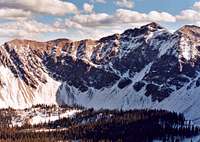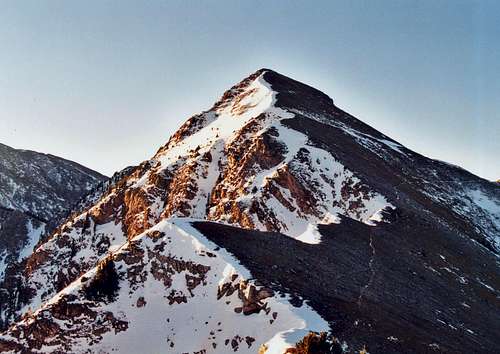-
 28394 Hits
28394 Hits
-
 90.48% Score
90.48% Score
-
 32 Votes
32 Votes
|
|
Mountain/Rock |
|---|---|
|
|
35.99170°N / 105.6459°W |
|
|
Rio Arriba |
|
|
Hiking, Scrambling |
|
|
Spring, Summer, Fall |
|
|
12990 ft / 3959 m |
|
|
Overview
UN 12,696, sometimes known as "Sheepshead Peak", and UN 12,900 are the northern outriggers of New Mexico's Truchas Peaks. Seldom visited, accessible as a dayhike or a fairly leisurely overnight, and lacking the vandalism issues associated with other area trailheads, these mountains are definitely among the most rewarding of the Pecos Wilderness. With steep faces overlooking the Trampas Lakes basin, the views of Las Trampas and Rio Quemado basins from these summits are New Mexico's alpine scenery at its finest, with plenty of craggy ridges and cliffs radiating from some of the state's highest peaks. Sheepshead has 476 feet of prominence, easily entitling it to official status; UN 12,900, however, falls somewhat short of the magic number. Either peak is a very worthwhile goal in its own right, though, and a traverse over these summits from Las Trampas offers one of the shorter means of access to North Truchas Peak.Getting There
Las Trampas trailhead is accessed from NM 76 via FR 207. If you are coming from Santa Fe or Espanola, you can take the very scenic High Road to Taos, which passes through Chimayo and Truchas. Take the easy-to-miss left in Truchas to stay on 76, and follow the road a little over 8 mile to Las Trampas. About a mile past Las Trampas, make a right onto FR 207. From Taos, take NM 518 to Penasco, then NM 75 west to Rio Lucio, then NM 76 about 4.5 miles. Turn left onto FR 207.Follow FR 207 through the picturesque community of El Valle to its end, approximately 8 miles.
FR 207 is a well-maintained dirt road that should pose no problems to passenger cars. Snow might be a problem, but Las Trampas is not a good place to go in heavy snow conditions in any case. The nearby Borrego Mesa and Rio Quemado trailheads are known for vandalism issues and problematic access (see here), but I have never heard of any such problems at Las Trampas, and the place generally feels safe. All of New Mexico has its share of scumbags, though, and it's probably wise not to leave valuables in your car.
Shortly before the trailhead and the end of the road, FR 639 branches off to the right. This road leads 1 mile or so to the trailhead for the San Leonardo lakes, which is a possible alternate approach to the peaks. FR 639 may be difficult in wet weather.
Approaches
The most straightforward approach to Sheepshead Peak and UN 12,900 is via Las Trampas Canyon. The trail starts out heading east, then hooks southward, leading to the Trampas Lakes in a little over 5 miles. Use of this area is moderate. In the summer you will probably see a few other hikers; in the off-season, you may well have the trail to yourself. The trail runs mostly through thick conifer forests, with a few aspen stands and some tantalizing views of the crags and ridges enclosing the drainage. It is not very steep, well-maintained and easy to follow overall, except for a few avalanche paths where numerous logs have fallen over the trail. (It might be more difficult to follow after snows; but when I hiked it by headlamp in November 2006, it had received enough traffic to be packed and easy to find all the way to the lakes.) There are three stream crossings, two on logs and one requiring some easy rockhopping. The trailhead elevation is 8,940 and the Trampas Lakes sit at 11,410.Other approaches are certainly possible. One such is via the San Leonardo Lakes (see "Getting There"); the approach hike is shorter at 4 miles, but the trail is reputed to be steeper and rougher than Las Trampas. One could also approach via Rio Quemado from the town of Truchas, or via the Borrego Mesa trailhead outside Chimayo; however, these trailheads are notoriously fraught with access and vandalism issues. Indeed, due to lack of these issues, the route from Trampas Lakes over Sheepshead's ridge is arguably the best access to the spectacular Rio Quemado Basin and Falls.
One tempting route that should be avoided is the ridge on the east side of Las Trampas drainage. It is easily accessible from near the elbow where Trampas Canyon hooks west, and from the saddle looks like a potentially fun ridgewalk and scramble. However, based on my experience trying to descend this route, it is not reasonable without technical gear. There are numerous sheer-sided gendarmes separated by loose and very steep gullies. It is very dangerous terrain with no bail-out options. Avoid it unless you're up for a very serious adventure.
One final option that bears mentioning is the ridge from North Truchas Peak. If you have climbed North Truchas via a different route, the scramble out to UN 12,900 would be a splendid side-trip if time and weather permit.
Red Tape
Standard wilderness regulations apply. Camping is prohibited within 50 feet of any stream or 200 feet of any lake. Please maintain good wilderness ethics: far too much of New Mexico's backcountry is trashed, and this seems to be a particular problem near lakes.There are no fees at Las Trampas trailhead.
Camping
Camping is permitted at the trailhead, where an outhouse is provided. You will see several campsites in the first couple miles of trail (some of which seem too close to the creek to be legal). I found a place to camp in the trees to the left of the trail near where it makes its bend southward. There are certainly campsites near Trampas Lakes, as well as at Hidden Lake. Hidden Lake is reached by a 1-mile spur trail which travels northward from Trampas Lakes along the west side of the drainage.Seasons
Autumn is probably the best time to visit this area, particularly September. The summer thunderstorms are usually over, weather is generally stable, people are few and aspens are turning. October usually brings a few snowstorms to the high country and you will probably find some left in the trees. Above treeline, however, snow usually blows away and melts quickly, even late in the season. I climbed these peaks in November; I camped on snow and found plenty in the forest and north-facing gullies, but the slopes and ridges were bare and easy.Summer is also a good time in the Pecos, green lush and cool. You may find substantial snow lingering well into June. Afternoon thunderstorms usually start up in mid-July and continue through August. Since climbing Sheepshead and UN 12,900 involves plenty of time above timberline, an early start and early descent is essential in monsoon season.
Winter is not a good time for most people to visit the Truchas area, though the increasingly common dry years may sometimes provide opportunities into December or even January. All the approaches to this area present avalanche danger, however, and would be long and tedious in heavy snow. This area is remote and help is a long ways away. You should have substantial winter mountaineering skills before attempting winter climbs here.
In the spring, the Pecos usually starts becoming accessible in May, though there are often opportunities in April in dryer years. Substantial amounts of snow may linger below treeline, making travel and routefinding difficult. For those with the necessary skills, the headwall above Trampas Lakes might offer some good snow couloir possibilities.
Weather

Maps & Resources
The Forest Service publishes a large-scale Pecos Wilderness map. Given the straightforwardness of climbing these peaks, this map is probably adequate.7.5-Minute USGS Quad: Truchas Peak
7.5-Minute USGS Quad: El Valle.
Dayhikes in the Santa Fe Area describes the hike to Trampas Lakes.
The Falcon Guide Hiking New Mexico describes both the Las Trampas and San Leonardo Lakes approaches.
These books, maps and many more can be found at The Travel Bug in Santa Fe.
Trip Report
Carson National Forest
Supervisor's Office
208 Cruz Alta Rd.
Taos, NM 87571
505-758-6200
Camino Real Ranger District
P.O. Box 68
Penasco, NM 87553
505-587-2255












